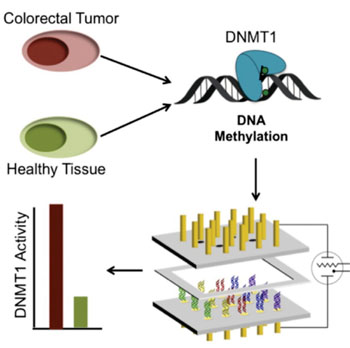Sensitive Technique Detects Colorectal Cancer in Tissue Samples
By LabMedica International staff writers
Posted on 14 Jul 2015
A new sensitive technique has been developed that is capable of detecting colorectal cancer in tissue samples and the method could one day be used in clinical settings for the early diagnosis of colorectal cancer.Posted on 14 Jul 2015
The technique measures the activity of a protein called DNA (cytosine-5)-methyltransferase 1(DNMT1) as a possible indicator of a cancerous transformation. DNMT1 is a methyltransferase, an enzyme responsible for DNA methylation which is the addition of a methyl group to one of DNA's bases.

Image: Schematics of a DNA-modified, two working-electrode arrays to measure methyltransferase activity from tissue samples (Photo courtesy of Ariel Furst/Caltech).
Chemists at the California Institute of Technology (Pasadena, CA, USA) devised an electrochemical platform to measure the activity of DNMT1 in crude tissue samples, those that contain all of the material from a tissue, not just DNA or ribonucleic acid (RNA), for example. Fundamentally, the design of the platform was based on the concept of DNA-mediated charge transport with the idea that DNA can behave like a wire, allowing electrons to flow through it and that the conductivity of that DNA wire is extremely sensitive to mistakes in the DNA itself.
The scientists started with two arrays of gold electrodes, one atop the other, embedded in Teflon blocks and separated by a thin spacer that formed a well for a solution. They attached strands of DNA to the lower electrodes, and then added the broken-down contents of a tissue sample to the solution well. After allowing time for any DNMT1 in the tissue sample to methylate the DNA, they added a restriction enzyme that severed the DNA if no methylation had occurred, and if DNMT1 was inactive. When they applied a current to the lower electrodes, the samples with DNMT1 activity passed the current clear through to the upper electrodes, where the activity could be measured.
Using the platform they measured DNMT1 activity in 10 pairs of human tissue samples, each composed of a colorectal tumor sample and an adjacent healthy tissue from the same patient. When they compared the samples within each pair, they consistently found significantly higher DNMT1 activity, hypermethylation, in the tumorous tissue. Notably, they found little correlation between the amount of DNMT1 in the samples and the presence of cancer; the correlation was with activity.
The authors concluded that DNMT1 hyperactivity as an indicator of cancerous transformation, measured electrochemically, is not clearly observed with the current standard techniques of DNMT1 analysis, including tritium labeling, reverse transcription quantitative polymerase chain reaction (RT-qPCR), and western blotting. Thus the electrochemical platform has the potential to provide a sensitive method of detecting DNMT1-related cancerous transformations, with greater reliability than current DNMT1 analysis techniques.
Jacqueline K. Barton, PhD, a professor of chemistry and senior author of the study, said, “The assay provides a reliable and sensitive measure of hypermethylation. It looks like hypermethylation is good indicator of tumorigenesis, so this technique could provide a useful route to early detection of cancer when hypermethylation is involved.” The study was published on June 25, 2015, in the journal Chemistry & Biology.
Related Links:
California Institute of Technology














